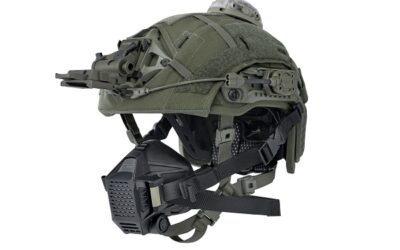Paratroopers’ Equipment
This abridged article (for full article, please see MT #3/2018 available at EnforceTac 2018 & IWA 2018, or order here) looks at how low-level parachutes and military freefall (MFF) remain primary insertion tactics for airborne and special operations forces (SOF). However, their utility is fraught with risk for the individual jumper, who must trust not only his parafoil solution but also meteorological data, his sponsor aircraft and his personal equipment.
As explained to MT by defence sources associated with the US Army Airborne School at Fort Benning, GA/USA, the personal equipment load of jumpers remains a critical element in the combat effectiveness of any parachute insertion. Critical to the mission is equipment weight, particularly weaponry and rucksacks, which can have an effect not only on speed of descent but also on balance. Poor weight distribution can result in spinning after exit, which can subsequently endanger the successful insertion of a paratrooper into a target area, sources explained.
On 5 January, the USMC awarded Airborne Systems North America a U$26.6 million contract to supply troops with the Enhanced Multi-Mission Parachute System (E-MMPS). Based on the company’s latest parachute solution – the Hi-5 canopy – the E-MMPS includes the provision of the EDGE harness container as well as an attachable military working dog harness, demonstrating additional mission capabilities, which must be… for full article, please see MT #3/2018 available at EnforceTac 2018 & IWA 2018, or order here.
Oxygen Systems
For higher altitude insertions, armed forces continue to stretch boundaries with regard to how much stress and fatigue personnel are able to deal with, while simultaneously maintaining sufficient cognitive capacity to successfully undertake follow-on missions subsequent to a high-altitude descent.
Examples include aircraft-borne and personal oxygen supplies carried by jumpers, the technologies for both of which remain critical requirements to prevent paratroopers suffering from hypoxia. Multiple casualties and fatalities have been caused over recent years, particularly in the SOF community, in cases in which operators have suffered from oxygen deprivation at higher altitudes with jumpers passing out before being able to open canopies.
Navigation
No matter how extensive a parachute’s glide ratio is, the combat effectiveness of a special operations MFF team, for example, could be severely limited without the ability to accurately navigate from sponsoring aircraft onto a designated drop zone. This, defence sources explained to MT, remains a critical element of any airborne insertion.
On 23 October 2017, US Army operators from 5th and 10th Special Forces Groups evaluated the Parachute Navigation System (PARANAVSYS) system in Laurinburg, NC. According to US Army officials, this particular solution comprises part of a wider soldier system designed to, “assist with planning and execution of high-altitude stand-off, MFF parachute operations.”
Chief of Test Division, Airborne and Special Operations Test Directorate, US Army Lt.Col. Greg Oquendo, explained how… for full article, please see MT #3/2018 available at EnforceTac 2018 & IWA 2018, or order here.
Andrew White

























